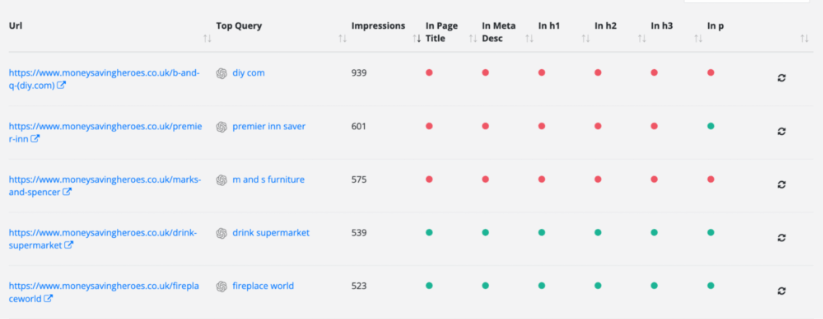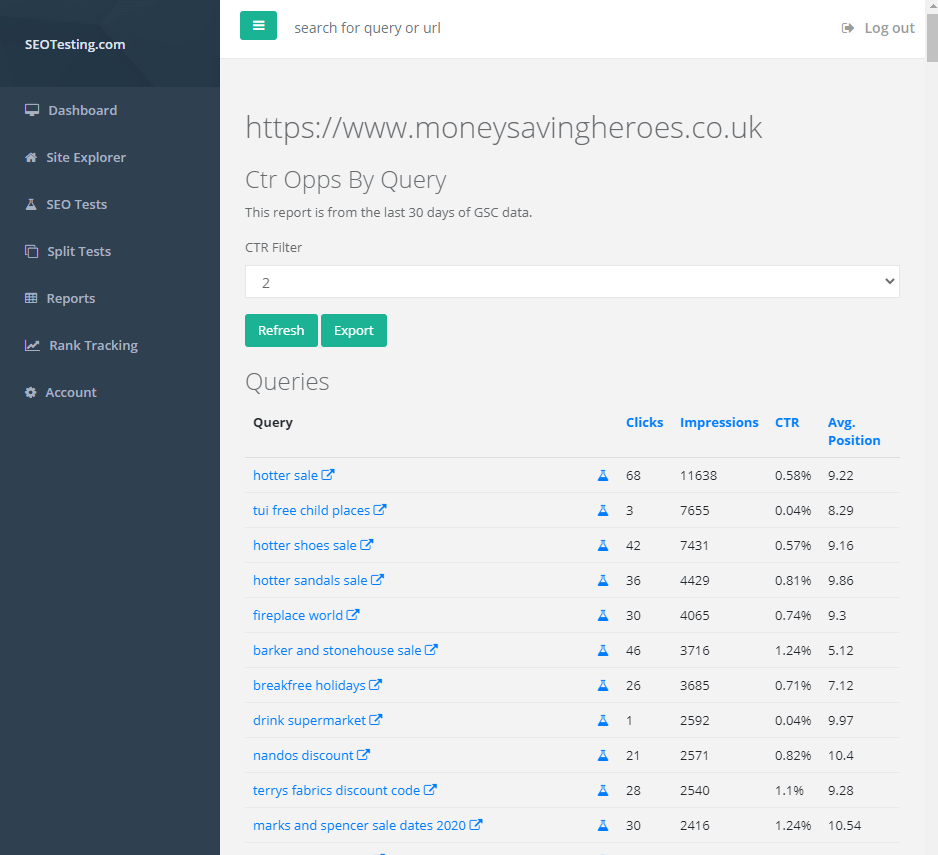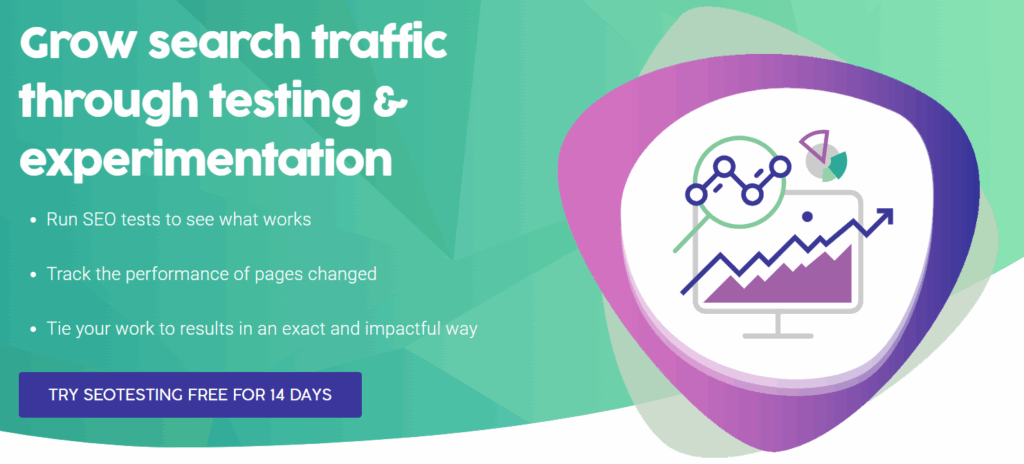Hitting Page One of Google is an incredible feeling, there is absolutely no doubt about it. But what happens when you realise you are not getting the clicks you want?
Google Keyword Planner says your chosen keyword is searched for approximately 20,000 times per month and you rank at Position Three, you should be getting a lot more clicks. Right?
Not necessarily. In this article, I will explain what an organic click through rate [CTR] is, whether it is actually a ranking factor and I will also give you some tips on how you can improve your CTR to ensure you are maximising the amount of clicks you are getting for your ranking.
As a bonus, I’ll also be giving you an incredible way you can find pages on your website that have a low CTR so you can optimise these (following our steps) and improve the number of visitors you’re getting to your website!
Ready? Let’s hop into it.
What is a Click Through Rate in SEO?
In this article we are referring to clicks to your pages from organic search engine results pages (SERPS), as opposed to click through rates from pay per click (PPC) advertising.
Broken down simply, a page’s click through rate (commonly referred to as CTR in a lot of cases) is how many clicks your page gets, divided by the number of times that your page appears in the SERPs. It’s also helpful to multiply this number by 100 if you want your CTR as a simple to understand percentage.
For example, if my website is seen 10,000 in the SERPs and it is clicked 1,000 times, that would be a CTR of 10%.
Click through rates are often tracked and measured based on:
- An entire site basis.
- A specific query basis.
- A specific query for a specific page.
The formula to calculate the click through rate is really simple:
Click through rate = (number of clicks an organic search listing gets / number of impressions a page gets in Google) * 100
Is your Click Through Rate a Ranking Factor?
This is a long debated question!
Oddly I will start with a conclusion – whether CTR is a ranking factor or not is immaterial.
Improving your click through rate will get you more clicks – so you should do it whether it is a ranking factor or not!
Until recently Google’s official line was that user signals such as click through rate, time spent on page, and bounce rate did not have any effect on a page’s ranking positions within the SERPs. However in the recent Congressional Hearings involving the big tech companies being investigated for antitrust issues – Google did admit that user signals were used as part of calculating where pages rank within the search results.
But given the above – the advice remains the same. Improve your click through rates to get more clicks, and if your rankings improve as a byproduct of this – that is even better.
What is a Good Organic Click Through Rate?
Very good question. We recently did a study on how click through rates have changed over the past 12 months. This study will give you an idea of average click through rates for the top 10 positions in Google. An important point the study makes is higher search volume keywords have quite a difference to long tail keywords.
Perfect. Now we have completely covered what a click through rate is, whether your click through rate is a ranking factor or not and what a good CTR is for your website. Now let’s jump into the really juicy information and tell you how you can find low CTR opportunities on your own website AND how to improve your CTR with very minimal work.
How to Find Low Click Through Rate Opportunities
We have two reports in SEOTesting.com that will help find low click through rate queries. These are both contained in the Reports section linked on the left hand side menu.
Top Query Per Page Report
The second report to checkout in SEOTesting.com is the ‘Top Query Per Page’ report.
This report will get you the top queries for a set of pages, and you can then see whether those top queries are used in the page title, meta description, headings and in paragraph text.
When you first head into this reporting section and create your first report, you will be able to determine the number of queries that are pulled through per page. The default setting (and maximum) is 10 queries per page, which I’d suggest sticking with.
You can then decide how many pages you want to retrieve for the report, the options as standard are 500 or 1000. 500 will be fine for most sites but if you run a larger website then it is advisable to go with 1000.
Within your report, which you can also download as a CSV for easy reading, you will get a whole host of incredibly useful information. This information includes the URL, page title, meta description, the query referenced as well as the click through rate.

These top queries aren’t in the pages’ titles or meta descriptions. Try adding them and testing.
It’s quite likely you’ll find pages that do not contain the top queries the page is appearing for in the search results in the page title or meta desc. Adding them in will make them bold in search results when they match the users search query, and you will often see an improvement in click through rate.
Low CTR by Query Report
The first report to checkout is the ‘Low CTR By Query’ report.

Easily pull up a big list of top queries with a low click through rate
This report will display queries that have a CTR lower than what is selected in the drop down filter. To start with, to find the really low hanging fruit, I would suggest selecting this value to be 1 or 2%.
You should then order the results displayed by impressions, as this will give you the queries that get the most impressions and therefore the biggest return if you can raise the CTR by one or two percentage points.

How to Improve Click Through Rates
If you’ve followed the steps above, you should now have a list of pages on your site that have a low click through rate and you’re chomping at the bit to fix this. I won’t hold you back any longer. Below you will find some of my best tips for improving the organic click through rate of a site listed in Google’s (or Bing’s) search engine result page.
Improve Page Titles and Meta Descriptions
As we have seen from our two reports in SEOTesting.com, finding queries that have a low click through rate for your pages is really easy.
Investigating the top queries your page is appearing for, and trying to include them in the page title and meta description is an easy way to get more clicks. This can usually be done through your websites content management system and so involves no developer time or coding.
If it makes sense to, include the query with the most impressions in the page title. Then include that same keyword, and the second and third most popular ones (or shorter variants) in the meta description.
You can see the full list of keywords a page is ranking by either:
1, Clicking on the url itself in any SEOTesting.com reports takes you to the page details page.
2, If you are looking at a report that contains queries, click on the query itself to see the query details page. On the query details page you’ll then see the urls that have ranked for that query over the past 7 days which you can click on to see all the other keywords the page ranks for.
3, You can also search for a specific url in SEOTesting via the search box at the top of the app. This will take you to the page details page.
Target Less Competitive Keywords
It’s also worth considering how competitive the top keywords are that a page is trying to rank for.
If for example you are targeting the top query ‘argos discount code’, which is already in your page title and meta description and has the numbers:
Impressions: 6,000.
Average position: 43.6.
Click through rate: 0.05%.
Clicks: 3.
Your site is having a hard time ranking for this keyword as it only appears at position 43.6 on average.
But you look a little further down the list of queries and spot the query ‘argos sale date’
Impressions: 1,000
Average position: 3.2
Click through rate: 1.0%
Clicks: 10
Although ‘argos sale date’ gets less impressions, you would get a better click through rate and more clicks if you were to target this less competitive keyword and include it in your page title and meta description.
Ensure your URLs are Descriptive
If you are anything like me, you will have looked at the URL of a result that Google has displayed before clicking onto a specific search result, and this is often one of the most crucial pieces of a good SERP listing that is left out.
Let’s say I was searching for the “best men’s mountain bike” and two URLs came up.
https://www.company.com/blog-mountain-bike-1932018
https://www.company.com/best-mens-mountain-bikes-2022
I know which one I would be clicking. Do you?
Changing your URL is really simple too, especially if you are working with a CMS such as WordPress. Just make sure to 301 redirect your old URL to your new URL if you need to change the link of a page that is already live on your site.
Implement Structured Data
One of the most effective ways to improve your click through rate is to implement structured data within your content. This sounds like it could be an incredibly complicated endeavour, but it is very simple in reality.
You do this using ‘Schema Markup’ which is, in essence, code that makes your content easier to understand to search engines like Google and Bing.
The advantages of doing this is it allows Google to display “rich snippets” on your result if they’re available, which makes your listing stand out more to the user and gives it a higher chance of being clicked. Even if the number of impressions remains the same. Therefore improving your CTR!
Think back… Have you ever searched for a food recipe? Whilst some search results may show a standard meta title and description, some other results may show a small image within the search result and potentially even some reviews. This is a rich snippet. And, of course, this is going to stand out more to users.
Optimise for SERP Features
Whilst some of us may not like it, SERP features such as Google’s “People Also Asked” feature are here to stay. And, in almost all cases, the feature with the biggest CTR is going to be the feature that appears at the very top of the SERP.
In some cases, that will be a PAA box, in other cases it will be a simple featured snippet.
In any case, and no matter what SERP feature shows at the very top of the search engine results page, you are going to get the best CTR if you optimise for these and successfully make it into the feature.
Actually doing this can be very straightforward, it can simply be a case of:
- Improving Headers within Content.
- Adding 1-2 Further Paragraphs of Text.
- Implementing Schema Markup.
I’m not going to bore you with the specifics of how to do this, there are plenty of amazing articles out there already to answer your specific queries on how to optimise for different search features. But know this… If you want the best CTR on a results page with SERP features, you need to optimise for these.
Fix Keyword Cannibalisation Issues
Right off the bat, this more than likely won’t stand out to you as a point about improving your click through rate directly. That’s because it isn’t.
But I still believe it is worth mentioning to you.
As we explained in our keyword cannibalisation guide, if you have two separate pages competing for real estate within the SERPs, you may find that both of these pages are lower than they could be. Removing one of these pages (almost always the lower ranking page) and implementing a 301 redirect to the higher ranking page will lead to a jump in ranking in most cases. This, because of the increased number of impressions, will generally lead to a higher CTR for your page as long as you have followed some of the tips we shared earlier.
Specific Things to Test with Page Titles and Meta Descriptions
Here are a few other things to consider and test when writing page titles and meta descriptions:
- Ask a question.
- Include the current month and year.
- Include a number – especially if it is a list type article.
- Include [ ] and other punctuation that might make your result stand out.
- Make sure they are unique across your site.
- Include a call to action or verb.
Check out the search result pages
One important thing to do, and this should be done before creating any new content as well as optimising existing content, just do a Google search for the query you are targeting and check the search results.

Writing a review of slippers? You might want to target a different keyword to get your blog post in the top 10!
If the query you target lists a load of products and ecommerce stores, you are really going to struggle to get a blog post describing or reviewing a product to rank.
This is all down to user intent, and what Google judges the user to be searching for.
You need to be matching the type of content you are going to create, with the type of content that is currently ranking for that query if you want any chance of appearing in the search results.
It is also worth checking out what search result features and structured data is displayed in the search results. If search listings have structured data pulled out and displayed, I highly recommend that structured data in your page as it vastly improves the appearance of your listing in the search results.
If a video carousel is displayed at the top of the search listing, consider recording a YouTube video that will complement your content and have a chance of appearing. It probably won’t directly affect the click through rate of the page on your site you are targeting for that query, but you’ll be getting more eyeballs on your content and brand which will help in the long run.
Always Set Up a Test!
Whatever you plan to change on your page titles and meta descriptions, always set up and run an seo test to see how your changes impact clicks, position and click through rate. Google and users are very unpredictable, so even the best thought out plans can bring unpredictable results! Get the data you need to be able to make informed decisions about your site.

Frequently Asked Questions
What is click through rate in SEO?
Click through rate (CTR) is the percentage of people who click your page after seeing it in search results. It is calculated by dividing clicks by impressions and multiplying by 100.
Is click through rate a ranking factor?
Google has debated this. Whether or not it is a direct ranking factor, improving CTR always leads to more traffic, which makes it worth focusing on.
What is a good organic click through rate?
It depends on your position and keyword type. Higher positions usually see higher CTR, and long tail keywords often perform differently from head terms.
How can I improve my click through rate?
You can improve CTR by optimizing page titles and meta descriptions, adding top queries to content, using structured data, and matching user intent in the SERPs.
How can I find low CTR pages on my site?
SEOTesting offers Low CTR by Query and Top Query Per Page reports. These show which pages and queries get impressions but low clicks so you can optimize them.

